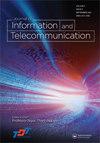Texture recognition under scale and illumination variations
IF 2.7
Q2 COMPUTER SCIENCE, INFORMATION SYSTEMS
Journal of Information and Telecommunication
Pub Date : 2023-10-07
DOI:10.1080/24751839.2023.2265190
引用次数: 0
Abstract
Visual scene recognition is predominantly based on visual textures representing an object's material properties. However, the single material texture varies in scale and illumination angles due to mapping an object's shape. We present a comparative study of the colour histogram, Gabor, opponent Gabor, Local Binary Pattern (LBP), and wide-sense Markovian textural features concerning their sensitivity to simultaneous scale and illumination variations. Due to their application dominance, these textural features are selected from more than 50 published textural features. Markovian features are information preserving, and we demonstrate their superior performance for scale and illumination variable observation conditions over the standard alternative textural features. We bound the scale variation by double size, and illumination variation includes illumination spectra, acquisition devices, and 35 illumination directions spanned above a sample hemisphere. Recognition accuracy is tested on textile patterns from the University of East Anglia and wood veneers from UTIA BTF databases.尺度和光照变化下的纹理识别
视觉场景识别主要基于代表物体材质属性的视觉纹理。然而,由于映射对象的形状,单个材料纹理在比例和照明角度上有所不同。我们对颜色直方图、Gabor、反Gabor、局部二值模式(LBP)和广义马尔可夫纹理特征进行了比较研究,研究了它们对同步尺度和光照变化的敏感性。由于它们的应用优势,这些纹理特征是从50多个已发表的纹理特征中挑选出来的。马尔可夫特征是信息保存的,我们证明了它们在尺度和光照变量观测条件下比标准替代纹理特征具有更好的性能。我们将尺度变化限定为两倍大小,照明变化包括照明光谱、采集设备和样本半球上方的35个照明方向。识别的准确性测试了来自东安格利亚大学的纺织品图案和来自UTIA BTF数据库的木饰面。
本文章由计算机程序翻译,如有差异,请以英文原文为准。
求助全文
约1分钟内获得全文
求助全文
来源期刊
CiteScore
7.50
自引率
0.00%
发文量
18
审稿时长
27 weeks

 求助内容:
求助内容: 应助结果提醒方式:
应助结果提醒方式:


